Identi-Beads and Identi-Badges as Strategies to Encourage STEM Identity Work
Connected Science Learning July-August 2021 (Volume 3, Issue 4)
By Alison Mercier and Heidi B. Carlone
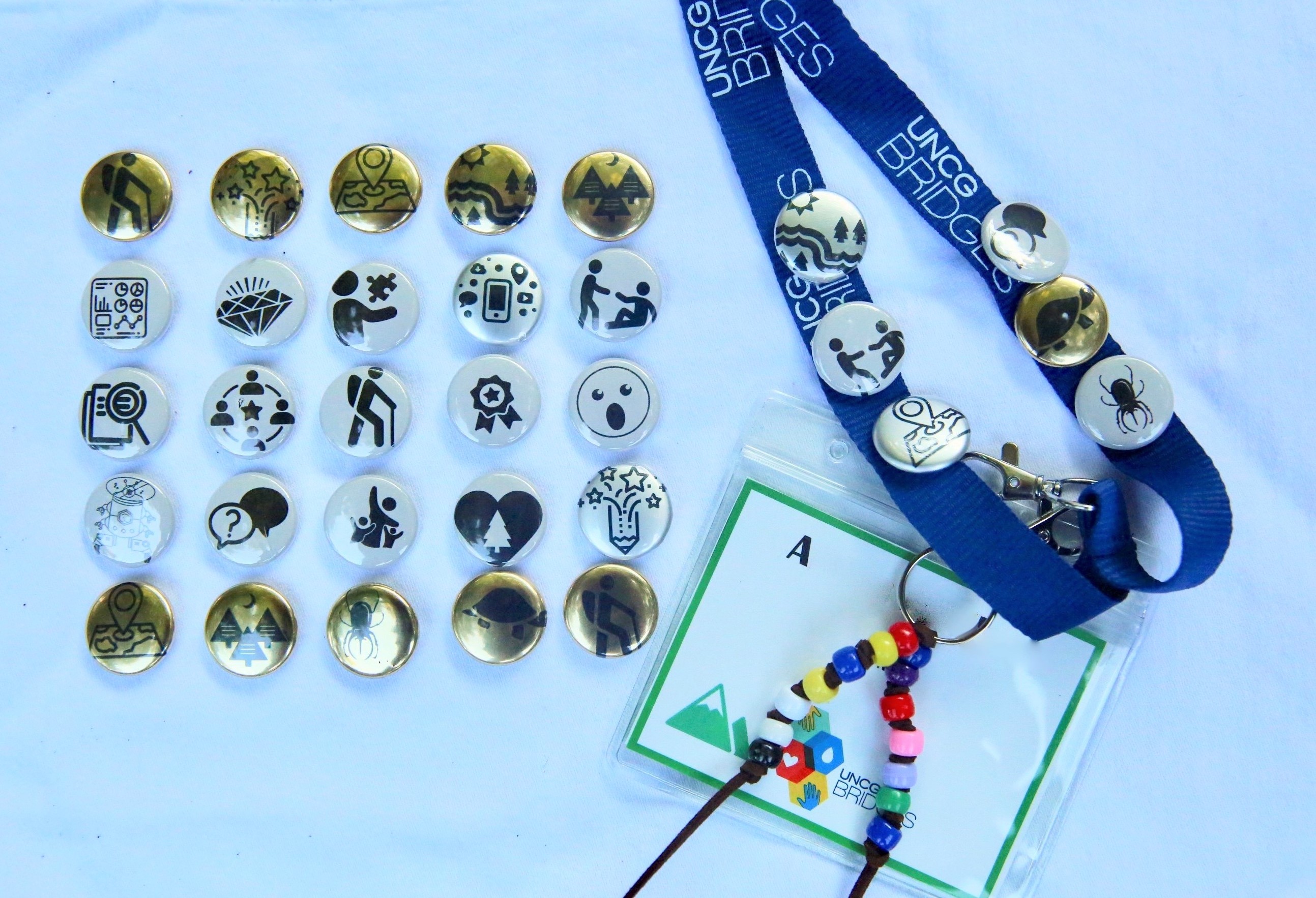
At the end of a long day of STEM activities in the five-week Saturday Academies, six middle-school youth gather around a bag of multicolored plastic beads. Each colored bead represents a mode of STEM engagement (e.g., pink represents investigator, white represents inventor, black represents tinkerer). Youth listen to their friends share why they’re selecting certain beads. Joaquin explains that he is selecting an inventor bead because of his logical thinking when solving a problem about best management practices in a design challenge earlier that day. Seventh-grader Kinsley pauses and says, “I feel like I was a little bit logical this week, but I don’t think I was enough of an inventor to get a bead. I guess there’s always next week.” Joaquin puts his hand on her shoulder in an encouraging way, “Maybe you could like challenge yourself to be more logical?” Kinsley thinks for a moment and replies, “I mean I’m not very much like that anyway, but I could try.” Similar conversations play out across the room.
This activity took place at the BRIDGES program (BRoadening Identities for Diverse Groups Engaging in STEM), designed to support middle school youths’ integrated, out-of-school STEM learning and identity work through environmental problem solving. With teachers’ help, we recruited youth with a diverse range of affiliation with STEM; some had little affiliation, while others were strongly affiliated. During end-of-day bead conversations, we noticed that youth took opportunities to reflect, name, and expand their participation and identity work in relation to STEM-like modes of engagement (e.g., tinkering, investigating, inventing). We named this the “identi-bead” activity, which was designed for youth to recognize the ways their participation aligned with STEM modes of engagement. We also designed an “identi-badge” activity as a way for adults and peers to recognize youths’ notable participation. Our team created this bead and badge system to surface identity-related conversations in a way that felt non-threatening and inclusive, and encouraged ongoing risk-taking and growth. This article describes the identi-bead and identi-badge activities, meanings youth made of these experiences, and their potential for opening up space for STEM identity work in a range of STEM learning settings.
STEM Identity Work and the BRIDGES Framework
We designed the identi-bead and identi-badge activities to use with STEM identity work. In the following sections we develop the idea of STEM identity work and describe how the BRIDGES framework makes components of recognition work accessible to youth.
STEM Identity Work
Increasing the accessibility of science, engineering, and technology for a wider range of youth involves more than increasing knowledge, skills, and interest. Some argue that, rather than fixating on achievement gaps, we should focus more on science identity gaps (Calabrese Barton et al. 2014) or the science debt owed to students who have been denied opportunities to meaningful STEM learning (Archer et al. forthcoming). Our work centers on designing spaces for youths’ STEM identity work, which involves providing opportunities to develop STEM competence (knowledge and practices) with problems that interest them, getting positioned by others as competent knowers and doers of STEM, and recognizing themselves as competent knowers and doers. We call this identity work because constructing a STEM-linked identity is inextricably connected to one’s social positioning (Carlone and Johnson 2007; Johnson et al. 2011). BIPOC girls, for example, often have more difficulty getting recognized as STEM competent by peers and adults in K–12 science (Brotman and Moore 2008), even if they perform better than White peers on assessments (Carlone et al. 2011). In turn, they may begin to take up a narrative that science is not for them or has nothing to do with their strengths and interests (Davis and Schaeffer 2019).
This kind of positioning—as competent or not, as STEM-promising or not, as smart enough or not—happens in overt and subtle ways in everyday interactions and practices. These may be obvious to those subject to deficit-based narratives but invisible to those invoking the norms to evaluate others’ STEM potential. Norms and expectations for what counts as a competent STEM person are not often made explicit or are not accessible to all learners. Even in informal science learning environments, it is all too common to invoke historically narrow definitions when making judgments about youths’ STEM interests and competence. Further, what counts as STEM competence in one setting might not count in another setting. All of this negotiation is subtly and not so subtly taxing for youth who want to author themselves as STEM-competent, interested, and promising. Authoring oneself involves “performing combinations of behavior, speech, and artifacts perceived as ‘appropriate’ as [one enters] new settings, drawing on [one’s history of practice] for these performances” (Johnson et al. 2011 p. 344). Others’ responses to this authoring may result in affirming or denying performances as credible, shaping who gets to belong in that particular STEM community. This is why recognition work is always a part of identity work (Carlone and Johnson 2007).
The BRIDGES Framework and the Six Modes of Engagement
Identi-beads and identi-badges activities surfaced recognition work. We wanted to demystify and operationalize characteristics of STEM competence and engagement so that youth could, right at the beginning of the program, recognize that their interests and proclivities for different activities were aligned with STEM. We wanted youth to know that they do not have to change who they are to participate competently—they already have what it takes. At the same time, we wanted to encourage youth to stretch themselves so that they could safely explore new experiences with curiosity. We developed the BRIDGES framework and modes of engagement to guide curricular and instructional approaches, provide youth and instructors shared vocabulary to broaden meanings of STEM, and strengthen youths’ affiliation to STEM.
The BRIDGES framework (Figure 1, see Supplemental Resources) focuses on the caring (doing good—the left side of the framework) and logical (sensemaking and problem solving—the right side of the framework) aspects of environmental problem scoping and solving while also highlighting ways to communicate and advocate for solutions (computing tools and practices—the bottom of the framework). The following modes of engagement represent multiple entry points and pathways for environmental problem solving: (1) altruism—caring deeply about people, their health, and their well-being; (2) conservationism—caring deeply about humans’ impact on the environment; (3) tinkering—building, making, and the process of trial and error; (4) designing—creating and designing with the beauty and function of a product in mind; (5) investigating—finding patterns in data and figuring out why and how things work; and (6) inventing—coming up with imaginative and creative ways to solve problems with material products. Identi-beads and identi-badges were designed with these modes of engagement in mind.
Identi-Beads and Identi-Badges
We designed identi-beads for self-recognition and identi-badges for recognition by others. Vivica and Joaquin describe the beads and badges as follows:
Maybe when people look at a bead, they just see a boring bead. But, this is really something deeper. They’re all little parts of who I am … I’d think about all the things I did and all the goals I had for myself. I thought about who I was in that day and what I accomplished and then picked the bead that kind of really connected to that. (Vivica)
So someone else nominates you for a badge and gives you a badge. The badges mean people really thought about me and what I was doing and thought I was doing great stuff. People thought about how I acted, but also what I was doing, what I was learning, and how I was talking about things. It’s like a secondhand perspective. It’s like someone looking in from the outside and telling you that you’re doing great. (Joaquin)
Identi-beads (Table 1 and Figure 2) and identi-badges (Figure 3, below, and Figure 4, see Supplemental Resources ) took on a life of their own throughout BRIDGES, becoming increasingly ritualized and spurring greater participation throughout the program. For example, during the summer camp, counselors held “bead ceremonies” (their term) in cabins at the end of each day as a means for youth to bond with one another and reflect on their daily activities and accomplishments. The identi-badges program became so popular that, by the end of the week, many youth and every adult nominated one or more campers for a badge. Delivered to youth at the end of each day, identi-badges resulted in group celebration and affirmation as youth pinned their badges to their lanyards.
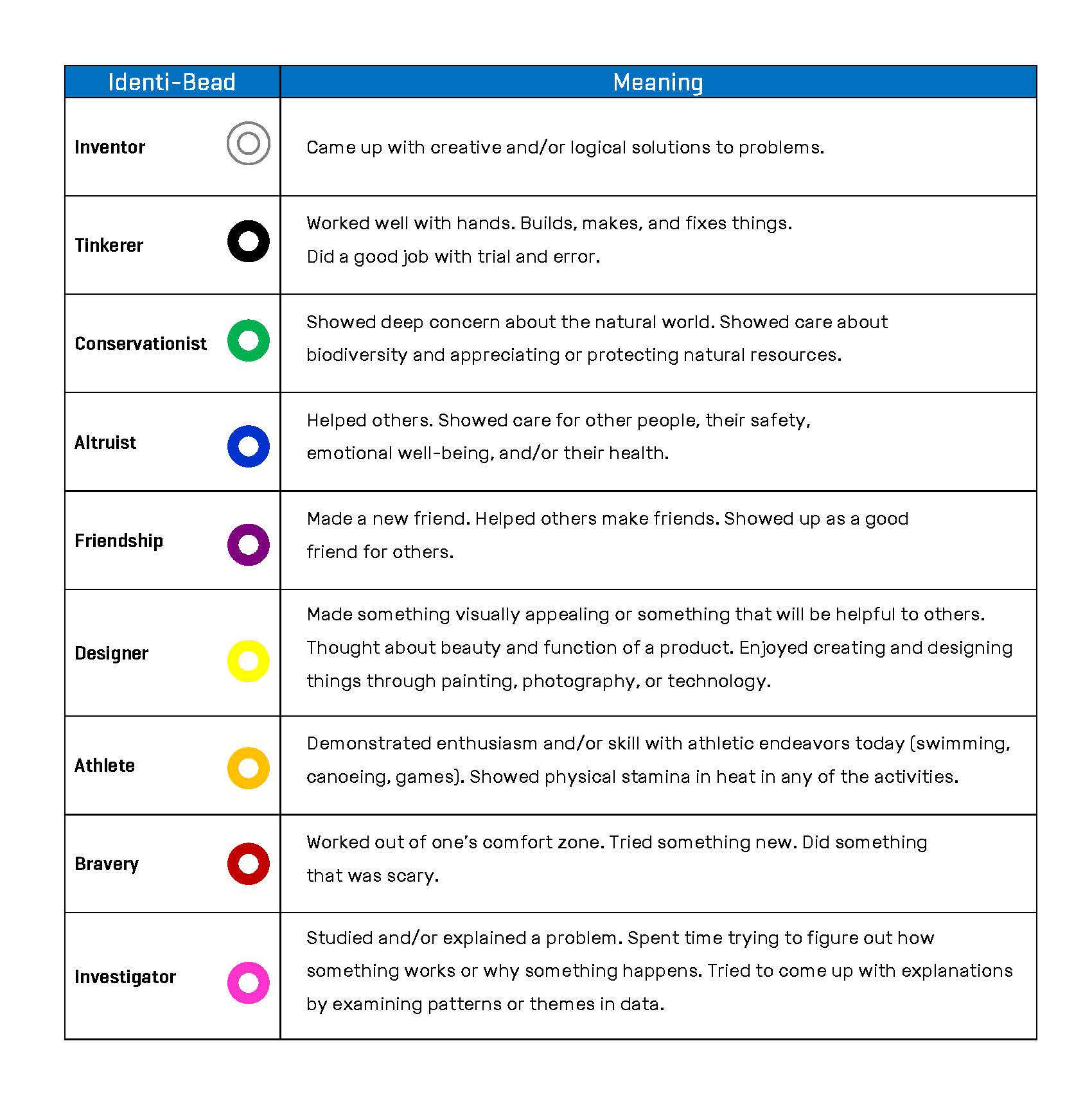
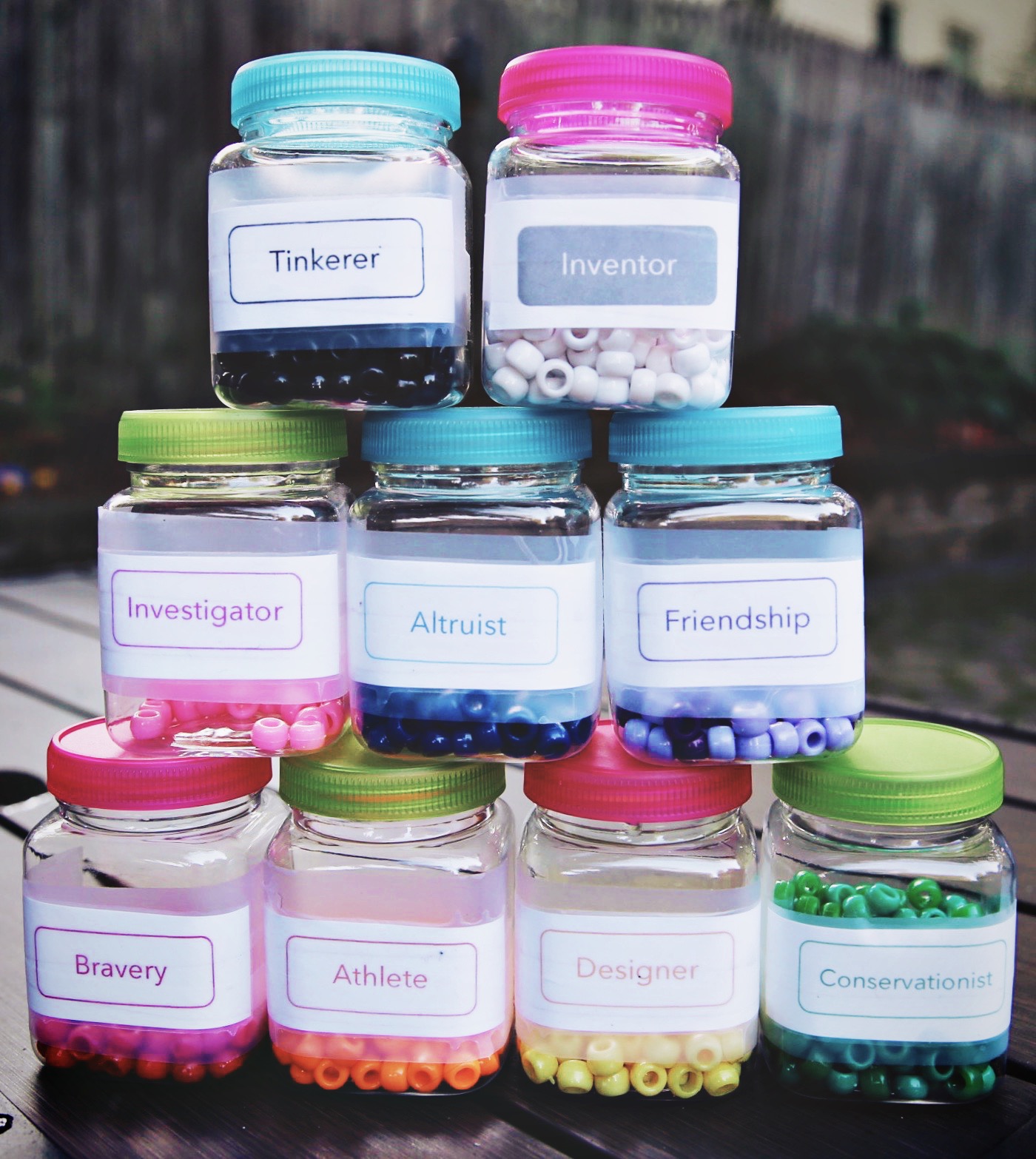
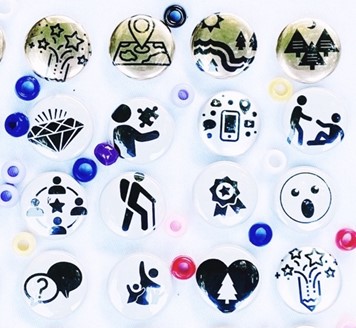
Putting Beads and Badges Into Action
The impact of the identi-beads and identi-badges program can be attributed, in part, to the program’s design and implementation. These activities could have quickly devolved into meaningless tokens or ways to reinforce hierarchies between youth. We carefully designed the activities to minimize the potential of these outcomes. During planning and training, we built in time to discuss the meanings, purposes, and organization of the programs, emphasizing that the modes of engagement were not to be interpreted as fixed states or in hierarchical ways.
Identi-beads were a way for youth to reflect on the day, recognize their achievements, and share their highlights with peers. We asked youth to select as many categories of identi-beads as they deemed relevant per day. In other words, they might have multiple beads of multiple colors each day. The beads prompted rich discussion; youth shared the reasons for their selection and the highlights of their day with peer groups. Counselors, teachers, and other team members facilitated these reflective discussions but allowed youth to drive the conversation.
BRIDGES team members and youths’ peers nominated individuals to receive identi-badges. We emphasized that badges were not participation awards. We aimed to recognize individual youth for outstanding engagement and focus on a wide range of excellence to minimize hierarchies within the group. We explained to youth that earning an identi-badge should feel like a true achievement; we celebrated wide-ranging achievements with an extensive variety of badges. We encouraged the BRIDGES team to be on the lookout for youth who made quiet contributions or who may have been overlooked, in addition to those whose outstanding performances were more visible and forthright.
Youths’ Meanings of Identi-Beads and Badges
To ascertain youths’ meanings of identi-beads and badges, we interviewed 73 youth at the end of two BRIDGES programs (n = 34 at a one-week residential summer camp in summer 2019 and n = 39 at a series of five consecutive Saturday Academies in spring 2020). We asked youth to tell us about their beads and badges and elicited stories of those that were most meaningful. In the following sections, we outline three themes: (1) new recognitions of self; (2) unexpected recognition by others; and (3) new ways of belonging in STEM. In Figure 5, we highlight these three themes, which we considered to be markers of youths’ identity work that emerged from the identi-beads and badges activities. The center of Figure 5 indicates themes across interviews that prompted youths’ identity work: (1) surprise; (2) affirmation; and (3) challenging myself. We provide brief examples of these themes.
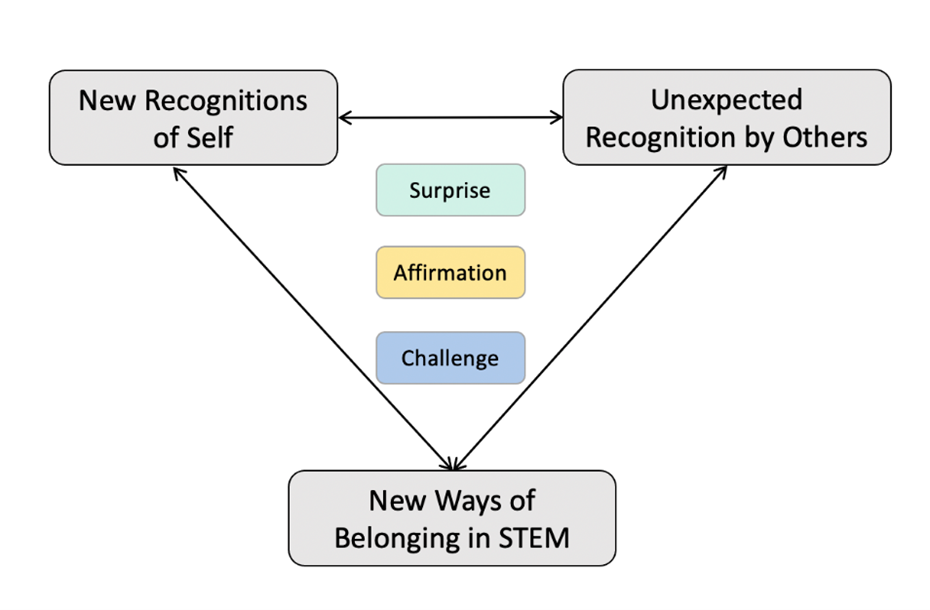
New Recognitions of Self and Unexpected Recognition by Others
Selecting their beads at the end of the day, publicly, in a small group that felt safe and friendly, prompted new recognitions of self. Youths’ earned badges similarly prompted new insights about and confidence in themselves, and an appreciation that “someone was paying attention to me” and “noticed me.”
Surprise
Claiming identi-beads provided youth an opportunity to reflect on their learning and accomplishments, bringing new realizations about their skills, interests, and STEM engagement.
[The identi-beads] reflect through what I did throughout the whole day and made me realize some things…I got more skills than I think. (Teona)
Every time I gave myself a bead or got a badge it felt sort of surprising because I didn't know how much stuff I could do. Because me, sometimes I be doubting myself, like, "I can't do that." (Trayton)
Speaking of an activity where youth had to examine evidence to find the source of water contamination in a model town, Abi said:
The investigator [bead] really surprised me because I thought of myself of more a designer. It turns out, I really like figuring out problems having to do with that.
Many youth were surprised to receive a badge or more than one badge; they often mentioned how meaningful it was that others noticed something special about them and how they engaged in the work.
It’s surprising to see that. Oh, people see me that way? Yay! (Raquel)
Oh, shoot! This [badge nomination form] says that I did an awesome job today and was fully engaged in the activity! Yeah. I did. (Kendis)
Affirmation
The identi-bead and badges activities affirmed youths’ identities as relevant for the work at hand. Fastened to their lanyards and nametags, identi-beads and badges were visual reminders that youths’ everyday participation was noteworthy. What they considered “just doing me” prompted some reflection that, perhaps “doing me” can contribute to the group’s work in meaningful ways.
It makes me feel good to know that I was nominated for each of these badges, because I didn’t really expect to get any … because I was just doing what I normally do. I was being Trayton. But, it ends up being a huge achievement, because it feels like little ol’ me is just doing me, and then it’s like this person or that person notices what I’m doing. Out of all people, me. I didn’t expect for people to think that what I did was all that special. It sort of made me feel important in a way. (Trayton)
I got this badge [pointing to her Geocache Master identi-badge] and I didn’t really think that I deserved it. I was just helping with the map and stuff. I honestly didn’t, I didn’t think I did anything special. But I guess people noticed that I did something, and they thought it was special. (Jacinta)
Five of the 73 youth minimized the meaning of the identi-beads, describing them as something along the lines of “just colorful beads,” yet the majority of youth attached significant meaning to the beads. For example, when we asked Joaquin about his most meaningful identi-bead, he struggled to choose just one:
They all relate to me. They are all me. They let me see who I am. I feel like investigator was one [most meaningful]. And maybe ... it's just because there's so [many beads] that could relate to me, but I don't really know which one's the top one. Because investigator, you really discover or really look into stuff and you really are curious, and you want to investigate more. And that makes me what I am. I'm a curious person. I want to learn more than I should be taught, or something …. Sometimes you don't really know how you are and what you do all day. And I feel like the beads were a reminder of what you are, and how you can be different things every day.
Joaquin surfaced a meaning of identity work as fluid, rather than fixed, a central theme we emphasized throughout the activities. Youth should not be bound to narrow constructions of self, and BRIDGES activities could be both affirming and horizon-expanding (Christine Cunningham, personal communication). We organized learning experiences for this fluidity, but we were not certain youth would take up this meaning of identi-beads and identi-badges. The next section is further evidence of this theme.
Challenge Myself
Youths’ discussions of their beads and badges indicated new ways they engaged as STEM-capable and interested. Many of the BRIDGES activities were novel experiences (e.g., sleeping away from home for a week, spending time on a college campus, seeing wildlife in their natural habitats, holding an aquatic turtle or a millipede, and identifying macroinvertebrates in a local body of water). The identi-beads and badges were ways to mark and celebrate those horizon-expanding experiences. As Ashley explained, “This is the investigator bead. I gave myself this bead because I spent part of my day identifying all the insects that we collected yesterday. I mean, who does that? I usually don’t.”
The bravery bead was one of the more commonly talked-about beads, often intertwined with discussions about trying something new or working out of one’s comfort zone.
I never knew I was so brave to … maybe touch a turtle, hold a turtle, hold a frog or a toad. I never thought I would be able to solve problems and never give up. (Raquel)
The designer [bead was most important to me] … because I don’t like building things because it’s just difficult. It’s just sometimes I really just can’t think about what to make or what to make it look like… So we had to design something that would fix the problem … [this] shows me that even if I don’t like to go out of my comfort zone, I still can and have fun while I’m doing it. (Jewel)
The youths’ recognition work prompted goal-setting for the next day’s activities. Jewel noted that she gave herself a designer bead for helping her group improve a water filter design, even though she never thought of herself as a designer. “It makes me think about how to do things different today. I want to be able to [give myself] a bead for doing other things, but I want people to see me trying new things, too.”
I was brave to do the stuff I did while I was here that I wouldn't do at home. [The badges] helped me see that. I think it changed what I did. They made me want to go harder and come back stronger the next day. (Teona)
Investigator [bead was most meaningful]. I didn't like figuring out how something works or why something happens, but once I joined BRIDGES, I got to investigate more and more stuff along the way. I just felt like this was the right choice for me to become an investigator. (Erica)
Erica’s comment points to the next big theme that emerged from our study: The identi-beads and badges activities—arising from challenging experiences that affirmed and surprised youths’ sense of selves—prompted new ways of belonging in STEM.
New Ways of Belonging in STEM
Our team smiled when, on the first day of the Saturday Academies after the Summer Institute, Antoine walked in with his BRIDGES lanyard, adorned with the badges and beads he earned the previous summer at camp. We took it as an indicator that the beads and badges were more than tokens for Antoine. We surmise from Antoine’s interview after the Saturday Academy that the beads were intertwined with identity work:
I feel like [the beads are] basically…you telling yourself what you think that you did. It’s not like anyone telling you what you did, it’s basically you showing yourself what you did. And over time you can see like different things that you did and that you said that you did and how you changed. (Antoine)
Belonging is an essential part of identity work (Lee et al. 2020), implying that one is a fit for the kind of work done at BRIDGES and the kind of people who do that work. Vivica illustrates the interconnections between identity work and belonging quite well:
I never knew I was going to get nominated this much. I had three people nominate me for this one [pointing to her water filter and stream flow badge]. Sometimes, when I was about to break down because I didn’t think I could do these things, I would look at my badges. And then I pushed through it. I thought about what I had accomplished, what other people thought I had accomplished. It made me feel good that people thought these things about me.
The identi-bead ceremonies, in particular, promoted social bonding and safe spaces for youth to feel like they were a part of the group.
It’s the way we connect. It gave us something to strive for… the beads meant a lot because we were getting to see our family grow because every time someone would get something I felt like I grew with them because they’re part of me and we’re all part of each other. (Nolan)
The social and the disciplinary aspects of the work were intertwined; feeling like a part of the group meant also feeling as though you were making contributions to the group’s work and well-being.
I told myself that I wanted to try and earn…the altruist bead, but I don’t just want it because I smiled at someone. I challenged myself to really go out there and help people and make a difference. I went out the next day looking for opportunities to help people and to step out of my comfort zone to be an altruist in whatever I did in BRIDGES. (Teona)
Identity-related discussions and their participation in BRIDGES activities allowed youth to see themselves in new ways, including as “STEM people” whose contributions mattered. Marisol sums it up beautifully:
I think that [Identi-beads and Identi-badges program] made us happy. I think we were like, ‘Hey, they're right. I did deserve this. I did do good in this. I'm proud of myself. I've learned something new. I’ve done something new. I think something new.’ So, I think the badges and the beads are a great way of showing that. They show me that who I think I am matters here.
Takeaways
An identi-bead or identi-badge was “not just another certificate,” as Roshni put it, nor did the beads and badges activities turn into a contest to see who collected the most. Instead, youth used the beads and badges as tools for recognition work—performing in new, surprising ways that prompted recognition by others and new insights about themselves and their fit in a STEM program. We surmise three reasons why the beads and badges were effective.
First, the data point to the power of engaging in novel experiences and the productive identity work entangled in that engagement. As youth engaged in and were successful in new activities, new realizations of self surfaced. We see great potential in using beads and badges in classrooms, but we are skeptical about their value to youth if they are applied to traditional classroom experiences. Thus, we recommend using beads and badges for new sets of experiences in and out of school that ease youth out of their comfort zones in new experiences.
Second, the language of the BRIDGES framework and beads and badges systems gave youth a vocabulary to use while reflecting on their BRIDGES engagement. Beads and badges made usually internal and implicit negotiations of identity, explicit and evident for youth, with studies inspired by the identi-beads program yielding similar results (Feldon et al. 2020). Like Femi said, “That badge made me think and I was like, huh, maybe I am a science person when I do that.”
Third, the program’s practices and discourse are unequivocally asset-based. In other words, we began with an assumption that all youth had interests and proclivities aligned with STEM. Without changing who they were, youth quickly learned that they had talents and contributions that were valuable to the group. While they made some shifts in their identity work, they were able to see from the very beginning that they belonged.
BRIDGES is designed so that youth can find ways to dig into STEM-related activities no matter who they consider themselves to be. Imagine the possibilities for youth to see themselves as “STEM kinds of people” in both in-school and out-of-school STEM settings. Imagine if learning environments were designed to open up space for STEM identity work. Identi-beads and identi-badges are one way of intentionally designing STEM-learning experiences to trigger youths’ STEM identity work. Recognition of youth, youths’ assets, and their place in STEM settings by others is important—it makes youth feel seen and valued.
Alison Mercier (amercier@uwyo.edu) is an Assistant Professor of Elementary Science Education at the University of Wyoming – School of Teacher Education in Laramie, Wyoming. Heidi B. Carlone is the Katherine Johnson Chair of Science Education at Vanderbilt University – Peabody College in Nashville, Tennessee.
Acknowledgments
This material is based upon work supported by the National Science Foundation under Grant No. 1657194. Any opinions, findings, and conclusions or recommendations expressed in this material are those of the authors and do not necessarily reflect the views of the National Science Foundation.
We thank Michelle Lovett for her contributions to the identi-bead program and Gabe Carlone for his contributions to the identi-badges program. We also recognize with gratitude the entire BRIDGES team and youth for the many ways they contributed to the success of the program.
citation: Mercier, A., and H.B. Carlone. 2021. Identi-beads and identi-badges as strategies to encourage STEM identity work. Connected Science Learning 3 (4). https://www.nsta.org/connected-science-learning/connected-science-learning-july-august-2021/identi-beads-and-identi
Environmental Science Equity STEM Teaching Strategies Informal Education

